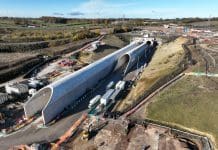UK construction output marginally expanded in April driven by the quickest rise in housebuilding so far in 2019, according to the latest construction PMI
Commercial work and civil engineering activity continued to decline, but at slower rates than in March.
The forward-looking survey indicators nonetheless remained subdued in April, with new orders falling for the first time since May 2018 and business optimism easing to its lowest since last October.
Concerns about the demand outlook resulted in more cautious staff hiring strategies in April, as highlighted by the first fall in workforce numbers since July 2016.
At 50.5 in April, up from 49.7 in March, the headline seasonally adjusted IHS Markit/CIPS UK Construction Total Activity Index posted above the neutral 50.0 threshold for the first time since January.
Housebuilding was by far the strongest performing area of construction work in April. Latest data revealed the rate of growth reaching its highest since December 2018. Survey respondents commented on resilient demand conditions and a strong flow of new buyers.
Commercial work was the weakest area of construction output in April, which continued the trend seen during the first quarter of 2019. A number of firms linked lower commercial construction to Brexit-related uncertainty and delays with client spending decisions.
Civil engineering activity also decreased in April, although the rate of contraction was only marginal. Some firms commented on a lack of new work to replace completed infrastructure projects.
Employment numbers fell slightly during April, which ended more than two-and-a-half years of sustained expansion. Survey respondents noted that lower business optimism and falling sales volumes had held back staff hiring.
Meanwhile, supplier performance deteriorated sharply in April, despite subdued demand for construction materials.
Stretched supply chains and rising raw material prices contributed to higher purchasing costs across the construction sector.
Duncan Brock, group director at the Chartered Institute of Procurement & Supply said: “The strongest rise in residential building since December 2018 was the only saviour of a sector otherwise heading for contraction again this month as deferred client decisions continued to impact on larger commercial and infrastructure projects, throwing the industry off-balance.
“Although the sector marginally moved into growth territory in April, there’s a huge question mark over whether there will be any further improvements in the coming months as new orders fell for the first time since May 2018. This lack of pipeline work has made firms more cautious about their hiring strategies with the first fall in employment levels since July 2016 in a bid to curb their rising costs and reduce their excess capacity.
“With the fastest rise in input costs since November 2018, material shortages, and stagnating workloads, the sector is slowly coming to terms with this new landscape of Brexit stalemate and its impacts with business optimism going through its worst phase since 2013.”
Following the release of the UK construction PMI figures, Phil Harris, director at BLP Insurance, added: “After bouncing back into expansion territory (50.5) following a two month period of contraction, it’s time for the construction industry to collectively stop ‘kicking the can’ down the road.
“The industry has been waiting with bated breath for some time for a Brexit resolution to give clarity amid palpable uncertainty. The extension of the Brexit deadline to the end of October, although not providing the assurance the sector seeks, means industry players can no longer afford to sit on their hands.
“We have seen some positive, if tentative, signs of activity in the last few weeks, with a number of blue-chip developers pushing through plans on schemes that had been on the back burner. The fundamentals of the residential market remain strong and further momentum in this space would be seen as a rallying cry to the wider industry, sending out a clear and strong message of progression.
“The Build to Rent (BTR) market is still buoyant and largely unaffected by the political quagmire our country is stuck in. Centred around a reliable business model, secure financing, and a willingness to push the envelope of innovation with its emphasis on offsite construction, BTR is thriving.
“While the spectre of Brexit remains on the horizon, a moderate industry-wide shift away from a regressive ‘wait and see’ mentality can create a more optimistic sentiment, acting as a springboard for future growth.”











![[VIDEO] Cambridge waste water plant granted permission to relocate Artist impression of the new Cambridge waste water plant and surrounding land](https://www.pbctoday.co.uk/news/wp-content/uploads/2025/04/p.151-768x364-1-218x150.jpg)


